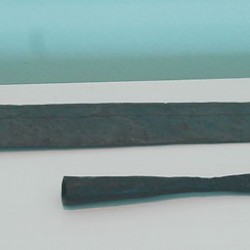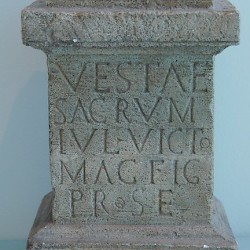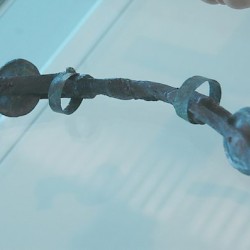Many objects tell a little story. I select the silver medallion that once belonged to one Gnaeus Aquillius Proculus, centurio of the Eighth Legion Augusta, found at the Kopse Hof auxiliary fort. This man is known to have played a role during the Batavian Revolt. When the forts along the lower Rhine were attacked, he was able to bring the garrisons to Nijmegen, where they were – for the time being – safe.
This would have been interesting enough: it is not often that archaeologists find an object that belonged to someone we know from the written sources. However, the object proves something else: that shortly before the revolt, the Romans sent soldiers of the Eighth legion Augusta, which was at that moment stationed at Sishtov in Bulgaria, to Nijmegen. This strongly suggests that the Romans were aware that the Batavians were becoming restless, which proves that the governor, Hordeonius Flaccus, was more capable than the historian Tacitus wants us to believe. He presents us with a Roman commander who is incompetent, indolent, and decadent, but archaeology proves otherwise.
The museum, which offers several other collections and a splendid view on the Nijmegen bridge (of World War II fame), is closed on Mondays. You can find photos from the museum here and here.
This museum was visited in a/o 2008-2019.
 Elst, Temple, Fragment of a wall painting
|
 Herennia Etruscilla
|
 Nijmegen, Kops Plateau, Helmet
|
 Cavalry mask, found in the river Waal
|
 Berg en dal, Silver pan, handle with portrait of Tyche or Cybele
|
 Beek, Milestone
|
 Nijmegen, Tombstone of Scanius of X Gemina
|
 Nijmegen, Monument to Tiberius: Ceres
|
 Nijmegen, Ring of a shoemaker
|
 Nijmegen, Monument to Tiberius: sacrifice
|
 The Herwen Mole Inscription
|
 Coin commemorating Drusus' German victories, minted by his son Claudius
|
 Lent, Frankish sword and spear
|
 Elst, Temple, Model
|
 Nijmegen, Inscription of an aquilifer of X Gemina
|
 Julia Soeamias
|
 Nijmegen, Kops Plateau, Imported mackerel
|
 Berg en Dal, Pottery factory, Tile
|
 Nijmegen-Hunerberg, Rim of an amphora, mentioning its Macedonian owner
|
 Ulpia Severina
|
 Berg en Dal, Pottery factory, Dedication to Vesta
|
 Rome, Forum Romanum, Temple of Janus, Coin
|
 Nijmegen, Noviomagus, Double temple, Mercury
|
 Nijmegen, Tambourine of a girl of about ten years old
|
 Nijmegen, Inscription of Bisius of X Gemina
|
 Nijmegen, Dedication by Candidinius, signifer of XXX Ulpia Victrix
|
 Nijmegen, Oil lamp with gladiators saluting the organizer of the games
|
 Nijmegen, Oil lamp, Mercury
|
 Nijmegen, Crystal dice
|
 Elst, Temple, diploma
|
 Lucilla
|
 Nijmegen, Agraphe with christogram
|
 Nijmegen, Amber carving of Amor
|
 Tiberius
|
 Coin of Vespasian, showing a personification of Judaea mourning the loss of her independence. Legend: JUDAEA CAPTA, "Judaea conquered".
|
 Nijmegen, Batavian horsemen
|
 Cornelia Superia
|
 Cavalry mask, found in the river Waal
|
 Nijmegen, terra sigillata with an inscription "Carnuntum"
|
 Nijmegen, Oil lamp, erotic scene
|
 Berg en Dal, Pottery factory, Tile with shoe print
|
 Julia Maesa
|
 Nijmegen, Amber portait of a girl
|
 Nijmegen, terra sigillata with the Thracian name "Mucatra"
|
 Nijmegen, Tomb of a girl of about ten years old
|
 Nijmegen, Monument to Tiberius: Diana
|
 Nijmegen, Tomb of a girl of about ten years old
|
 Valentinian I
|
 Cavalry mask, found in the river Waal
|
 Nijmegen, Valkhof, Oil lamp with Victoria
|
 Nijmegen, Kops Plateau, Helmet
|
 Nijmegen, Dedication to the Mopatian Mothers by Liberius
|
 Nijmegen, Objects from the tomb of a fourth-century lady
|
 Nijmegen, Glass vase
|
 Otacilia Severa
|
 Aquilia Severa
|
 Nijmegen, Noviomagus, Double temple, Fortuna
|
 Berg en dal, Silver pan
|
 Roman coin, commemorating the annexation of Arabia Nabataea
|
 Nijmegen, Oil lamp, Jupiter and his eagle
|
 Nijmegen, Terra sigillata
|
 Nijmegen, Late Roman pottery
|
 Nijmegen-Hunerberg, Civil settlement, Unfinished bronze statuette of Luna
|
 Tiel, Runic inscription
|
 Nijmegen-Hunerberg, Early Helmet
|
 Nijmegen, Crystal ring
|
 Nijmegen-Hunerberg, Officers' mansion, Wall painting of a deer and a peacock
|
 Nijmegen, Bridge, pile-shoe
|
 Cavalry mask, found in the river Waal
|
 Nijmegen, Monument to Tiberius: Apollo
|
 Nijmegen, British mirror
|
 Faustina II
|
 Nijmegen, Kops Plateau, Aquillius Medal
|
 Nijmegen, Inscription mentioning three relatives in X Gemina
|
 Theodosius I
|
 Bronze object mentioning LEG HISP IX, from Ewijk
|
 Nijmegen-Hunerberg, Cavalry mask from the Beekmansdal
|
 Copy of an inscription from Rome, mentioning Noviomagus
|
|
|













































































